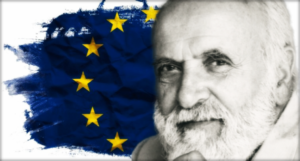 by Dr Alan Hick
by Dr Alan Hick
Dr Hick is a Board Member of New Europeans International and a former senior official at the European Economic and Social Committee
1st May 2022
This article has been reproduced with kind permission from New Europeans
The first time I met Altiero Spinelli did not go well. As a young researcher at the European University Institute in Florence preparing a PhD on the history of the European Movement, I had read about Spinelli and arrogantly thought to myself – at last, someone who thinks like me! Needless to say, his “back-story” was a lot more prestigious.
An anti-fascist militant against Mussolini, he was arrested in 1927, imprisoned for ten years and confined for a further six on the island of Ventotene where, in June 1941, he and fellow prisoners Ernesto Rossi and Eugenio Colorni clandestinely drew up a Draft Manifesto “For a Free and United Europe”. The Ventotene Manifesto for a post-war democratic European Federation was a key rallying call of the Italian and European Resistance and European Federalist Movement. Sadly, post-war, their radical blueprint for European Federation was neglected and usurped by the neo-functional Jean Monnet model. Spinelli was nonetheless rightly considered as a “pioneer” and “founding father” of European Union. He played a significant role in post-war politics and was a European Commissioner from 1970 to 1976. After that, at the time I met him, he was an Italian MP (Deputato della Repubblica Italiana) for the “Independent Left”, not yet a directly-elected MEP.
My meeting with him was not pre-arranged but improvised – not a good idea! It was 12 May 1977, on a sunny day in Rome. He was to give a lecture that evening and I thought I could introduce myself at the end. For some reason, I preposterously wore a three-piece suit that I had bought for my best-friend’s wedding the previous year. When I got to Rome I was boiling hot and went for a drink not far from where his lecture would take place. I went to a small bar at Largo Argentina, just off Piazza Navona. As I sunk a beer, I heard the shutters slam down all around. I dashed outside to see what the commotion was about and got entangled in the front-line of an illegal demonstration that was soon fired at by the police with exploding teargas cannisters aimed directly at us on the square and by violent fascists shooting at us from a windowsill above. There were several casualties, and one student girl was tragically killed. I managed to get away, got to Spinelli’s lecture in a state of shock and excitement and ludicrously presented myself at the end of the meeting. He was rightly and clearly annoyed that I had the presumption he would be interested in me. I don’t think he was too impressed, either, by my three-piece suit! I left the room and Rome, embarrassed and forlorn…
Fortunately, a few weeks later, my thesis-director, Prof. Walter Lipgens, kindly put me in touch with one of Spinelli’s federalist soul-mates, Andrea Chiti Batelli. We had a long and deep conversation about my research on Italian federalism and my serious understanding of, and sympathy for, Spinelli’s constituent vision for Europe. He promised to put in a kind word for me and arrange a meeting sometime in the near future.
Time passed and not much happened … except that I fell in love with a beautiful Florentine and got married soon after, in January 1978. We went on our honeymoon to her parent’s holiday home in Ortisei (Alto Adige). We couldn’t ski but ably sledged around all the surrounding hills and mountains, catching a chill and a slight cold. But it didn’t matter, because we were in love … and I had completely forgotten about Spinelli!
In the middle of our honeymoon, Andrea managed to get in touch with me. Spinelli wanted to see me, forthwith, in Rome. We had to leave immediately and could stay at Andrea’s place, on the outskirts of the capital. My understanding wife kindly agreed and we hurriedly took the night train from freezing Bolzano to sunny Rome! Our colds disappeared and Andrea was delighted to host us, celebrate together and imbibe rather a lot of his delicious Sicilian wine!
The next day, Andrea accompanied us to our luncheon appointment with the great man himself. Spinelli, I learned, loved his food, and this was Andrea’s yearly “feast” with him. We all met at a long table with other federalist friends at a wonderful fish restaurant, La Rosetta, just behind Piazza Rotonda and the Pantheon. I sat next to Spinelli who served us and was utterly charming and fascinating. He loved sincere, like-minded company, and my wife and I were completely in awe of him! What a privilege it was. Our honeymoon took on a totally new dimension. He invited both us to meet up with him again, the day after, Tuesday 17 January 1978, in his parliamentary office.
We met and discussed all morning. He very much liked the fact that I had exposed in my research the fundamental and disastrous split within the post-war federalist movement between the “Hamiltonian” constitutionalist wing in favour of political federation, represented by Spinelli, and the “integral federalist” wing, represented by ex-Vichy corporatists and nostalgists for the so-called “living forces”. This split seriously undermined the federalist input to the grand Congress of Europe in May 1948 and initially hampered the federalist development of the European Movement. To my astonishment, at the end of our cordial discussion, he handed me a manuscript, freshly typed by his daughter Diana, of his personal “European Diary” for those immediate post-war years, published some time later by il Mulino. I was the first historian bestowed with this honour. He had confidence in me and kindly recorded in his diary for that day that he considered me to be an authentic “spinelliano.”
After our long talk, Spinelli accompanied us to the lift where we briefly met his wife, Ursula Hirschmann, who, those thirty-seven years previously, had bravely smuggled the Ventotene Manifesto out of the island on the back of cigarette papers, concealed in the false bottom of a tin box. She was frail and dignified. Spinelli adored her.
The Spinelli “European Diary” was a very precious primary source material for my PhD which I completed a few years later, extracts of which were published in “Documents on the History of European Integration” (Walter de Gruyter 1991). Unfortunately, this was too late for Spinelli who sadly died in 1986.
In the intervening years, we stayed closely in touch. He was, of course, elected to the European Parliament in 1979. During the same campaign, I worked for an avowedly federalist Labour candidate in the UK, Ernest Wistrich, who was not elected. Shortly after, I worked for Brian Key MEP who was a close supporter of Spinelli in Parliament and in the renowned “Crocodile Club” (another British MEP who supported Spinelli was a certain Stanley Johnson …). I later went back to Rome and met up again with Spinelli on a few occasions. In his diary for 18 February 1982, he recorded that he wanted to “take me under his wing” and that he must find the time to read my thesis. However, he was by then totally absorbed with his draft Treaty Project for European Union, still inspired by Ventotene and the idea of the European Parliament becoming a constituent assembly. I was proud to be associated with him and his project at such an early stage. On 23 July that year, when he thought that his much-accomplished parliamentary assistant, Virgilio Dastoli, could be leaving, he wrote in his diary that he might invite me to replace Virgilio. I knew nothing of this at the time. Virgilio of course stayed and was a loyal and successful aide to Spinelli as he steered his Draft Treaty through the European Parliament by a massive 237 votes to 31, with 43 abstentions on 14 February 1984. By then, I had become an EU official at the European Economic and Social Committee, doing what I could in that more modest setting to rally support for Spinelli.
Sadly, I didn’t try to see Spinelli in person those last few years. He had become so admired and famous that I felt it was inappropriate to profit from our earlier times together. The last time I saw Spinelli in person was actually on 11 September 1982 at a Festa dell’Unità gathering at Tirrenia. He was on a panel of distinguished politicians rambling on and he was extremely bored. He started to cut out paper dolls with his programme, then spotted me in the crowd and called me over. We chatted amiably and he left me his new business card, on which was written “Ciao Hick”. I still have it and treasure it. His handwriting was appalling! So much so, that when his second “European Diary 1976-1986” was typed up and published, I am listed in the index, not as Alan, but as Yvonne Hick! I think we both would have enjoyed the joke!
I always remained a loyal “spinelliano” and will never forget how he changed my life … and my honeymoon.






Leave A Comment